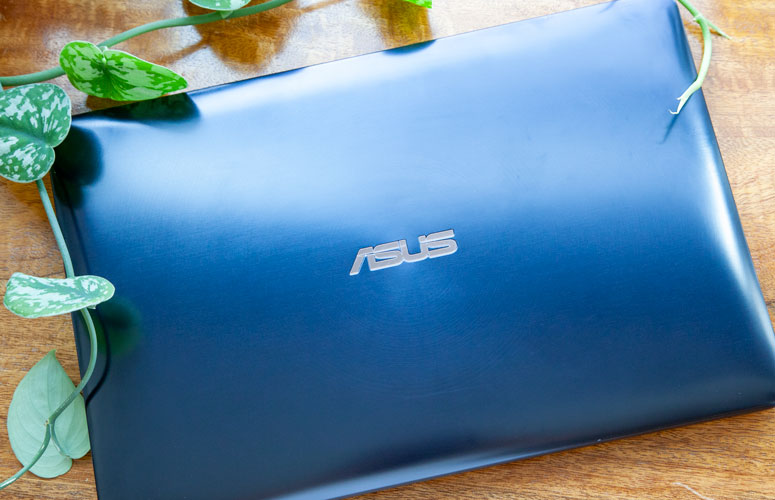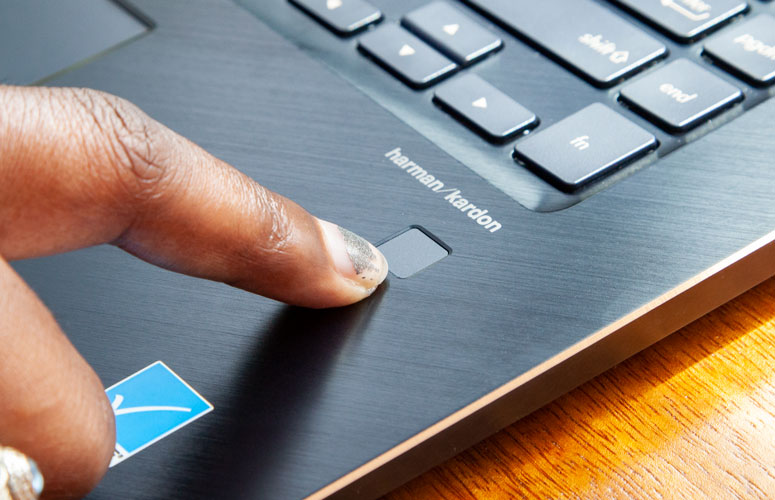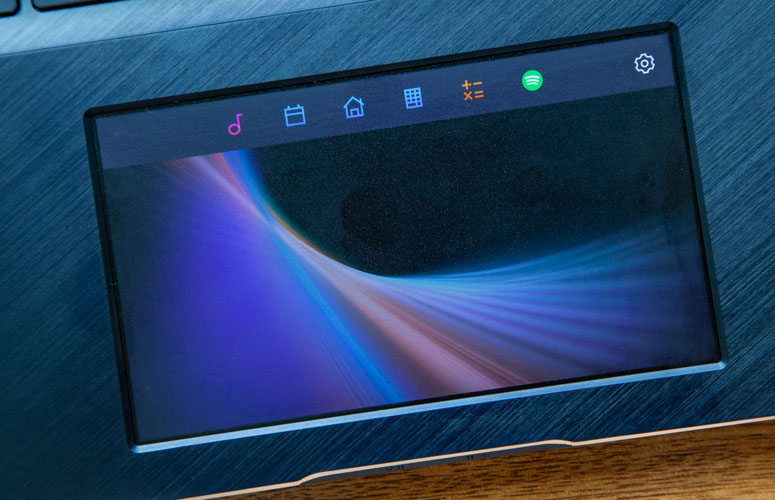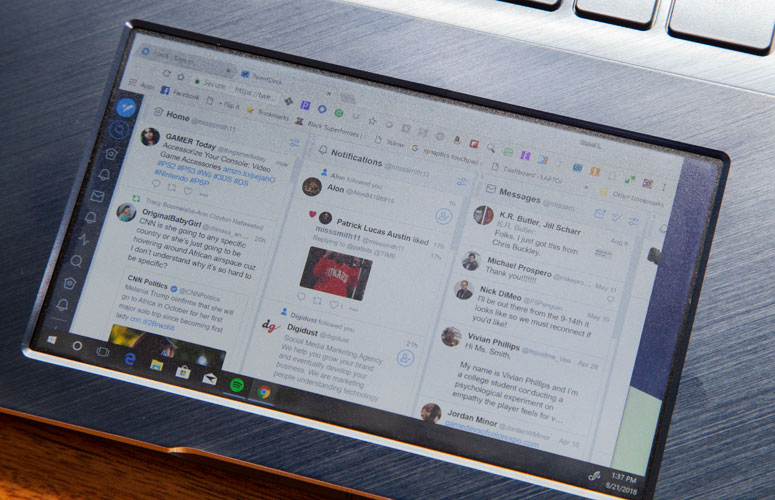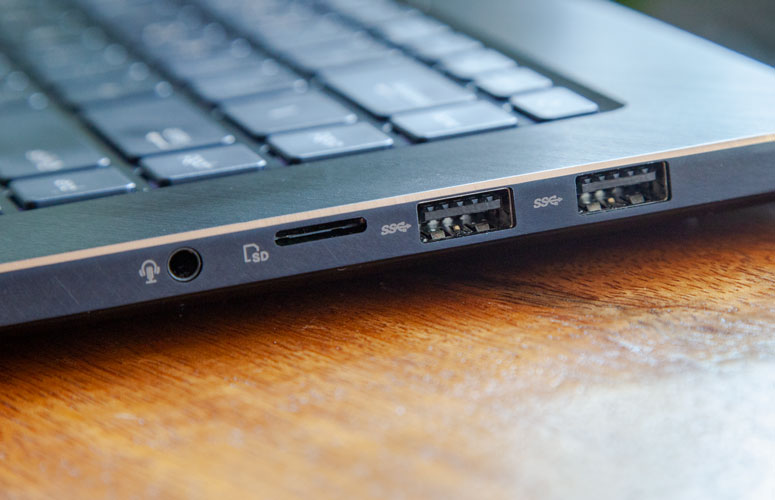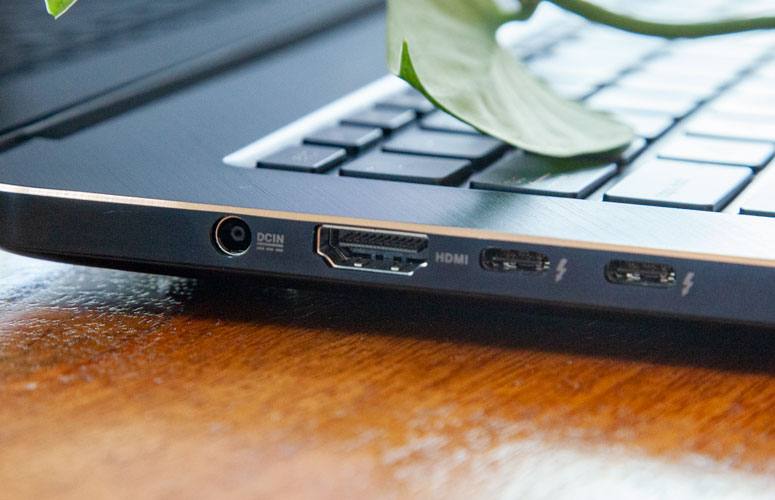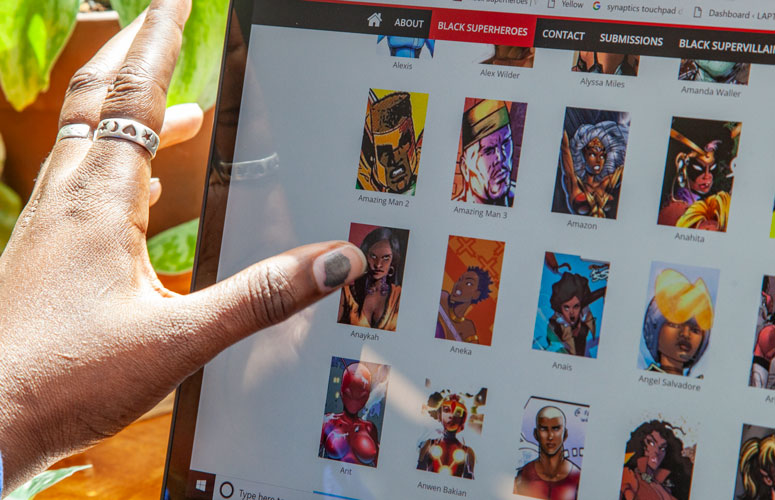Laptop Mag Verdict
The Asus ZenBook Pro 15 deftly combines power and sophisticated design with a unique touchpad display, creating a system ideal for pros.
Pros
- +
Elegant, sophisticated design
- +
Powerful overall and graphics performance
- +
ScreenPad complements productivity tasks
- +
Lightning-fast transfer speeds
- +
Supervivid, 4K touch screen
Cons
- -
Below-average battery life
- -
Low-res webcam
Why you can trust Laptop Mag
The Asus ZenBook Pro 15 doesn't just look good; it works damned hard, too, making it a great choice for mobile professionals. For $2,299, you get a slim, sophisticated system with a jaw-dropping 4K display, a Intel Core i9 processor, an Nvidia GTX 1050 Ti GPU and a smoking-fast SSD.
And, on top of all that, you get the ScreenPad, an LCD display that can switch on the fly between a touchpad, a music player, a productivity shortcut toolbar and a viable second display, which add up to a combo platter worthy of being called one of the best Asus laptops and best video editing laptops. However, because of all that tech fanciness the battery life takes a noticeable hit, essentially tethering mobile and creative professionals to a power outlet.
Design: My blue heaven
When I look at the ZenBook Pro, I have visions of a beautiful woman in a sleeveless, deep-blue, mermaid-tail evening gown taking the floor at a grand ball, the lights twinkling alluringly on her rose-gold jewelry. Yes, it's a grandiose description, and a sign I need a fancy night out on the town, but with Asus' Deep Dive Blue aluminum chassis and golden, chamfered edges, the laptop is just that sublime.
Look closer at the lid (and how could you not?), and you'll notice the concentric circles lightly etched into the metal, topped off by a golden Asus logo.
Open the laptop, and you get more of that exquisite blue metal. But unlike the lid, the striations are on a diagonal slant. The keyboard rests in a slightly recessed space toward the top of the deck. I love Asus' attention to detail, with the gold-colored font on the keys. Directly below the keyboard lies the ScreenPad, glowing with promise and expectation (more on that later). And if you take a glance under the Fn key, you'll see a Windows Hello-compatible fingerprint scanner.
Measuring 14.4 x 9.9 x 0.7 inches, the ZenBook Pro weighs 4.2 pounds, which is on a par with the Dell XPS 15 (4.2 pounds, 14.1 x 9.3 x 0.5~0.7 inches) and the Microsoft Surface Book 2 (4.2 pounds, 13.5 x 9.9 x 0.9 inches). The 13.8 x 9.5 x 0.6-inch Apple MacBook Pro 15-inch is just a tad lighter, at an even 4 pounds.
Sign up to receive The Snapshot, a free special dispatch from Laptop Mag, in your inbox.
ScreenPad: Two displays are better than one
This isn't the first time we've seen a laptop with two displays (think back to the Asus Taichi) or even the first time we've seen the second screen used as a touchpad (see the original Razer Blade Pro). But this is the first time it's been so seamless. In addition to the lovely 15.6-inch panel at the top of the laptop, Asus added a 4.8 x 2.6-inch, 1920 x 1080 LCD touch screen called the ScreenPad, which can quickly adapt to what you're doing for easier multitasking.
You can use the ScreenPad in four modes: Traditional TouchPad, ScreenPad, Extension Display and Disable TouchPad. Traditional TouchPad gives you a blacked-out panel and functions only as a Windows Precision Touchpad.
Featuring seven icons (Music Player, Calendar, Launcher, Num Pad, Calculator, Spotify and Settings), the toolbar allows you to quickly interact with a number of apps that make it a viable productivity tool. I used the calculator to figure out the laptop's file-transfer speed and Launcher to boot apps and utilities, including Microsoft Edge, OneDrive and LinkedIn.
This isn't the first time we've seen a laptop use a touchpad as a second screen, but this is the first time it's been so seamless.
I was a little annoyed that I had to download Spotify before I could use it, but once it was installed, I liked having it just a tap away. You can add up to 24 apps or utilities to the Launcher via the Edit screen for a bit of personalization.
My favorite aspect of ScreenPad mode is the intelligent adaptive design used for Microsoft Office programs. As soon as I launched Word, the ScreenPad launched a complementary toolbar, which allowed me to change the font type, color or format, as well as save, print and open documents. Using the pad quickly became second nature, and I appreciated having a large screen to work with instead of the tiny strip that Touch Bar-equipped MacBooks offer. I'm hoping that Asus is planning to bring this functionality to Google Docs and its cloud-based productivity apps, which are becoming more popular with consumers.
Using Extension Display mode, I transformed the ScreenPad into a true second display. Once the mode is activated, the ScreenPad mirrors the main display, allowing you to interact with the icons and launch programs. It's cool, but to get the full experience, you'll need to go to the Display Project menu and select Extend. From there, I dragged a window with my Facebook feed down to the ScreenPad while I wrote the review and let a wireless mouse take over navigation duties. It's a clever way to mimic the two-display setup I have going at work and saved me the trouble of having to lug around a mobile display.
MORE: Best Hard Drive Speed
Overall, I enjoyed using the ScreenPad, but I wish the actual setup were a little clearer. To get the YouTube app to work, I had to enable it in the Extensions section of Google Chrome. And it took a random YouTube video for me to figure out how to really use Extension mode, even though Asus added both a video and a scroll-though tutorial.
Ports
While it's not bursting at the seams with ports, the ZenBook Pro has enough to create a nice mobile work or gaming station.
On the right, you'll find a pair of USB 3.1 Type-A ports, a microSD slot and a combination microphone/headphone jack.
To the left sit two Thunderbolt 3 ports, a full HDMI port and a jack for the DC adapter.
Display: Everything is splendid
The ZenBook Pro's display is lovely. The 15.6-inch, glossy, 4K (3840 x 2160) touch screen is luminous and capable of delivering vivacious color. When watching the Samsara trailer, I was transfixed by the mummified visage of the Tollund Man, his skin stained ebony black from hundreds of years in the inky bog. I could see every wrinkle and indentation in his face and every piece of stubble. It was almost as if he were going to awaken from a magical slumber, if not for the rope around his throat.
Like most Asus laptops, the ZenBook Pro comes with the company's Splendid utility, which allows you to adjust the screen's color temperature. You can choose from three presets -- Normal, Eye Care and Vivid -- or set the temp yourself using Manual. I preferred using the Vivid setting, as it gave colors an extra pop. It also made whites look white and not yellow as the other settings did.
The 15.6-inch, matte, 4K (3840 x 2160) touch screen is luminous and capable of delivering vivacious color.
The ZenBook Pro's eye-catching hues come from its ability to re-create a whopping 141 percent of the sRGB color gamut, which is well above the 111-percent premium-laptop average. The Microsoft Surface Book 2 came the closest to matching the Asus, at 131 percent. The MacBook Pro and the Dell XPS 15 notched respectable scores of 117 and 115 percent.
When we measured brightness, the ZenBook Pro's display averaged 330 nits, topping the 307-nit average. However, the MacBook Pro (354 nits), the XPS 15 (371 nits) and the Surface Book 2 (417 nits) were all brighter.
MORE: Laptops with the Best Display Brightness
The ZenBook's 10-point capacitive touch panel is fast and very responsive. I couldn't detect any lag when I started doodling in Fresh Paint. For the artists out there, the display is compatible with Asus' optional Pen, which costs $49.99.
Audio
The ZenBook Pro's bottom-mounted Harman Kardon-tuned speakers are pretty loud for a laptop this size. They had no problem filling my bedroom with relatively loud and clear audio. I listened to several tracks, including Kanye West's "Flashing Lights," Bruno Mars' "Perm" and Aretha Franklin's "I Say a Little Prayer." On each track, I was treated to clean instrumentals, like the strum of a guitar, crisp percussion and wafting violin chords. The bass, however, wasn't very strong, due to the lack of a subwoofer.
Keyboard
With 1.1 millimeters of key travel (slightly below our 1.5-mm average) and 65 grams of force actuation required (our accepted minimum is 60 grams), the ZenBook Pro's backlit keyboard is nice and bouncy.
Despite the shallow travel, I never felt my fingers bottoming out, which made for a pleasant typing experience. Still, at 65 words per minute on the 10fastfingers.com typing test, I was a little below my usual 70-wpm rate.
Performance
With great looks and considerable power to match, the ZenBook Pro can stand toe-to-toe with competing systems, thanks to its 2.9-GHz Intel Core i9-8950HK processor with 16GB of RAM. It can multitask with the best of them, easily streaming an episode of Disenchantment on Netflix while running a system scan with 18 other open tabs in Google Chrome, some of which were streaming Twitch or running Slack.
The laptop also performed well on our synthetic test, hitting 21,691 on Geekbench 4.1, which measures overall performance. That was enough to soundly top the 13,944 premium-laptop average and the 21,201 put up by the Dell XPS 15, which has a Core i7-8750H CPU. However, the Asus wasn't a match for the 15-inch MacBook Pro, whose own 2.9-GHz Intel Core i9-8950HK CPU achieved 23,138.
During our productivity test, we tasked the ZenBook Pro with pairing 65,000 names and addresses in Excel. The notebook finished in a lightning-fast 40 seconds, roasting the 1:29 category average and the 1:31 posted by the Microsoft Surface Book 2. The XPS 15 and the MacBook Pro fared somewhat worse than the Asus, with times of 0:44 and 0:52.
We had the ZenBook Pro duplicate 4.97GB of multimedia files from one folder on the laptop's 512GB NVMe SSD to another. It finished in 12 seconds, for a transfer rate of 424.1 megabytes per second, beating the Surface Book 2 (1TB PCIe SSD, 318.1 MBps) and the XPS 15 (256GB M.2 PCIe SSD, 221.3 MBps). However, the ZenBook Pro was a bit short of the 475.2-MBps average and nowhere near the rate from the MacBook Pro's 2TB SSD: a ridiculous 2,599.6 MBps -- the highest rate we've recorded on this test.
MORE: Laptops with the Best Productivity Performance
During the video transcoding test, the ZenBook Pro transcoded a 4K video to 1080p in 10 minutes and 53 seconds. That's faster than the 20:39 average and the Surface Book 2's 23 minutes, but both the XPS 15 (10:12) and the MacBook Pro (10:16) were faster.
Graphics: Game on
Thanks to its Nvidia GeForce GTX 1050 Ti GPU with 4GB of VRAM, the ZenBook Pro can deliver solid frame rates on many AAA games, depending on the settings. For instance, the notebook produced 60 frames per second on the Hitman benchmark, matching the Dell XPS 15's GTX 1050 Ti GPU and our 30-fps playability threshold. Still, it wasn't enough to hit the 82-fps premium-laptop average or the Microsoft Surface Book 2's (GTX 1060 GPU) 72 fps.
Thanks to its Nvidia GeForce GTX 1050 Ti GPU with 4GB of VRAM, the ZenBook Pro can deliver solid frame rates on many AAA games.
The ZenBook Pro 15 notched 31 fps on the Grand Theft Auto V test, beating the XPS 15's 27 fps but falling short of the 43-fps average. The Surface Book 2 scored even higher, at 45 fps.
When we ran the Rise of the Tomb Raider benchmark, the ZenBook Pro matched the MacBook Pro (AMD Radeon Pro 560X GPU) at 21 fps but missed the 40-fps category average. The XPS 15 edged out both laptops, with 22 fps, while the Surface Book 2 scored 33 fps.
MORE: Best Graphics Performance
When you aren't saving the world or creating your own, the ZenBook Pro switches over to its Intel UHD 630 Graphics GPU using Nvidia's Optimus technology.
Battery Life: Short-lived
The ZenBook Pro 15 got hit with a triple whammy. Thanks to its 4K panel, secondary display and discrete GPU, the laptop's battery life took a serious hit. It lasted only 4 hours and 23 minutes on our battery test, which forces continuous web surfing over Wi-Fi at 150 nits of brightness. We also left the ScreenPad on at full brightness. When we disabled the ScreenPad completely, the notebook lasted 5:14. However, after a Windows update, the result jumped to 6:01. It's still not a full work day, but still better than our original result.
None of these results are anywhere close to the 8:16 premium-laptop average. The ZenBook Pro did manage to beat out the Microsoft Surface Book 2 in tablet form (3:12). But combined with its lower half, the system clocked in at 11:34, while the 15-inch MacBook Pro posted a time of 10:21. The 1080p version of the Dell XPS lasted 11:53, while the 4K model tapped out at 8:28.
Heat
With its all-metal chassis, the ZenBook Pro 15 can get a little hot under the collar. Asus incorporated a dual-fan system with three heat pipes to disperse some of the hot air, which works to a certain extent. After the laptop played an HD video for 15 minutes, the ScreenPad measured 84 degrees Fahrenheit, while the middle of the keyboard hit 94 degrees. The system's bottom measured 102 degrees, surpassing our 95-degree comfort threshold.
Webcam
For such a premium laptop, Asus saddled the ZenBook Pro with a pretty chintzy webcam. After taking several extremely grainy shots in my bedroom, I was confused by the image quality (or lack thereof). Then, I checked the resolution and discovered that the ZenBook Pro has a 640 x 480 shooter, whereas competing systems have 1920 x 1080 cameras. The one bright spot is the color accuracy, which gave a good representation of my deep-magenta shirt, brown headboard and royal-blue wall.
Software and Warranty
Asus bundled some proprietary software on the ZenBook Pro. There's Installation Wizard, as well as Live Update to install critical programs, keeping your system up-to-date. In case you want to toggle the top row of keys between HotKeys and Function, there's the Asus Keyboard HotKey Utility.
The ZenBook also has some bloatware courtesy of Windows 10, including Drawboard PDF, Netflix and a link to purchase Adobe Photoshop. For gamers, the notebook also has Nvidia GeForce Experience to help optimize the gaming experience.
The Asus ZenBook Pro 15 ships with a one-year limited warranty with the company's Accidental Damage Protection at participating stores. See how Asus fared on our Tech Support Showdown, Best and Worst Laptop Brands and Best and Worst Gaming Brands special reports.
Configurations
I had a ball reviewing the $2,299 iteration of the Asus ZenBook Pro 15, which has a 2.9-GHz Intel Core i9-8950HK processor with 16GB of RAM, a 512GB NVMe SSD, an Intel UHD 630 Graphics GPU and an Nvidia GeForce GTX 1050 Ti GPU with 4GB of VRAM.
MORE: Longest Battery Life Laptops
The $1,799 base model uses a traditional touchpad and offers a 2.2-GHz Intel Core i7-8750H CPU instead of the Core i9 processor.
Bottom Line
It's hard to make a fad a legitimate thing, but Asus might have pulled it off with the ZenBook Pro 15. The $2,299 laptop brings back the idea of the two-display laptop and makes it viable, swapping out the traditional touchpad with an LCD panel dubbed the ScreenPad. Using adaptive technology to intelligently launch shortcuts for productivity apps and acting as a true second screen open up loads of possibilities for creative and mobile professionals alike.
Plus, you get an absolute beauty of a notebook, which, despite its svelte dimensions, manages to fit an extremely powerful Intel Core i9 processor and an entry-level Nvidia GPU into the mix with a fast SSD. And let's not forget that incredible 4K panel.
Still, as useful as that second panel is, combined with that lovely 4K display, it's an absolute battery killer, with just over 4 hours of battery life with the ScreenPad enabled. For just $1,549, you can get the Dell XPS 15, which lasts over 11 hours and has its own show-stopping display. You'll lose a bit of performance power, as it offers only a Core i7 CPU, but it's still a serious workhorse and a light gaming system. But if you're looking for a laptop that can take your multitasking to the next level, few machines can compete with the Asus ZenBook Pro 15.
Credit: Laptop Mag
Asus ZenBook Pro 15 Specs
| Bluetooth | Bluetooth 5.0 |
| Brand | ASUS |
| CPU | 2.9-GHz Intel Core i9-8950HK processor |
| Card Slots | microSD |
| Company Website | www.asus.com |
| Display Size | 15.6 |
| Graphics Card | Nvidia GeForce GTX 1050 Ti/Intel UHD 630 Graphics GPU |
| Hard Drive Size | 512GB |
| Hard Drive Speed | n/a |
| Hard Drive Type | NVMe PCIe SSD |
| Highest Available Resolution | 3840 x 2160 |
| Native Resolution | 3840 x 2160 |
| Operating System | Windows 10 Pro |
| Optical Drive | None |
| Optical Drive Speed | n/a |
| Ports (excluding USB) | USB 3.1 Gen 1, HDMI 1.4, Headset, Thunderbolt 3 |
| RAM | 16GB |
| Size | 14.4 x 9.9 x 0.7 inches |
| Touchpad Size | 4.8 x 2.6 inches |
| USB Ports | 4 |
| Video Memory | 4GB |
| Warranty/Support | 4.8 x 2.6 inches |
| Weight | 4.2 pounds |
| Wi-Fi | 802.11ac |
| Wi-Fi Model | Intel Wireless-AC 9560 |

Sherri L. Smith has been cranking out product reviews for Laptopmag.com since 2011. In that time, she's reviewed more than her share of laptops, tablets, smartphones and everything in between. The resident gamer and audio junkie, Sherri was previously a managing editor for Black Web 2.0 and contributed to BET.Com and Popgadget.
